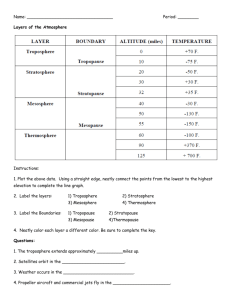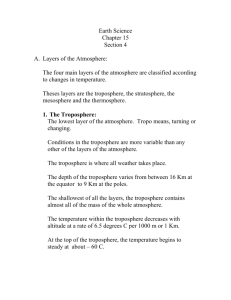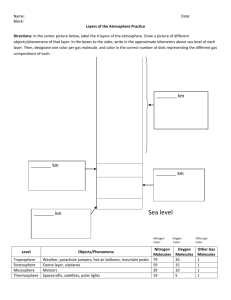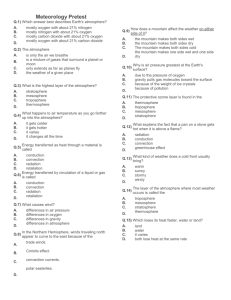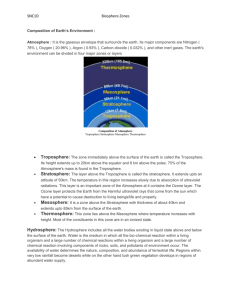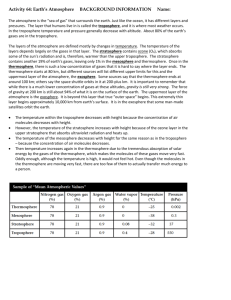ES.4
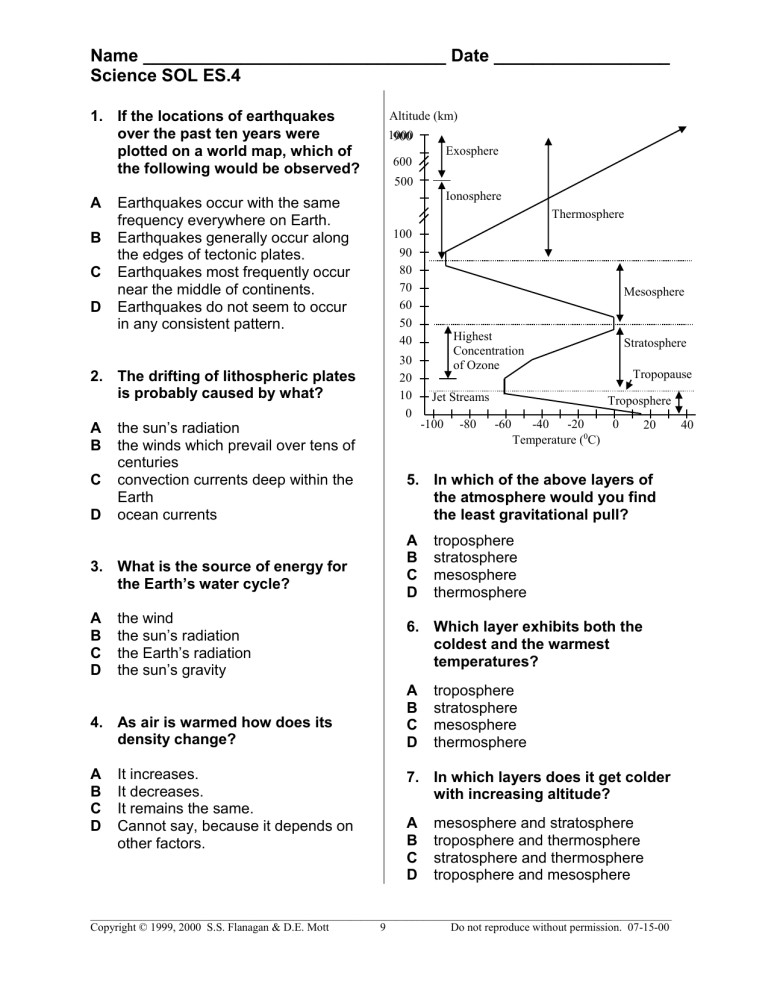
Name _______________________________ Date __________________
Science SOL ES.4
1. If the locations of earthquakes over the past ten years were plotted on a world map, which of the following would be observed?
A Earthquakes occur with the same frequency everywhere on Earth.
B Earthquakes generally occur along the edges of tectonic plates.
C Earthquakes most frequently occur near the middle of continents.
D Earthquakes do not seem to occur in any consistent pattern.
2. The drifting of lithospheric plates is probably caused by what?
A the sun’s radiation
B the winds which prevail over tens of centuries
C convection currents deep within the
Earth
D ocean currents
3. What is the source of energy for the Earth’s water cycle?
A the wind
B the sun’s radiation
C the Earth’s radiation
D the sun’s gravity
4. As air is warmed how does its density change?
A It increases.
B It decreases.
C It remains the same.
D Cannot say, because it depends on other factors.
Altitude (km)
600
Exosphere
500
Ionosphere
100
Thermosphere
90
80
70
60
50
40
Mesosphere
30
20
Highest
Concentration of Ozone
Stratosphere
Tropopause
10
0
Jet Streams
-100 -80 -60 -40 -20
Temperature ( 0 C)
Troposphere
0 20 40
5. In which of the above layers of the atmosphere would you find the least gravitational pull?
A troposphere
B stratosphere
C mesosphere
D thermosphere
6. Which layer exhibits both the coldest and the warmest temperatures?
A troposphere
B stratosphere
C mesosphere
D thermosphere
7. In which layers does it get colder with increasing altitude?
A mesosphere and stratosphere
B troposphere and thermosphere
C stratosphere and thermosphere
D troposphere and mesosphere
_______________________________________________________________________________________________________
Copyright © 1999, 2000 S.S. Flanagan & D.E. Mott 9 Do not reproduce without permission. 07-15-00
Name _______________________________ Date __________________
Science SOL ES.4
8. At what altitude does the majority of protection from the sun’s radiation end?
A 10 km
B 50 km
C 80 km
D 1000 km
Use the table, Descriptions of the
Inner Planets, to answer the next 2 questions.
Description of the Inner Planets
Diameter Orbital Atmosphere Period of
(km) Velocity
(km/sec)
Rotation
(hours)
1.
12,104
2.
12,756
3.
6,794
4.
4,880
35.0
29.8
CO
2
N
2
, O
2
,
CO
2
, H
2
0
5,832
24.0
24.2
CO
2
, N
2
, Ar,
O
2
, H
2
0
47.8
24.5
H
2
, He, Na 1,408
9. Identify the planets.
A 1 – Mars, 2 – Venus, 3 – Earth, and
4
– Mercury
B 1
– Mercury,
2
–Venus ,
3
– Earth, and 4 – Mars
C 1 – Venus, 2 – Mars, 3 – Earth, and
4
– Mercury
D 1 – Venus, 2 – Earth, 3 – Mars, and
4 – Mercury
10. Which one of the four following descriptions of planets is mostly correct?
A Venus – like Earth in many ways but has run-away greenhouse effect that makes it very hot.
B Mars
– extremely thin atmosphere, one side very hot and the other side very cold.
C Mercury – considerably colder than
Earth and covered with a thick, dark atmosphere.
D Venus – like Earth in many ways but is colder, has a much thinner atmosphere, and not much water or oxygen.
Use the diagram below to answer the next three questions.
A
B
D
11. On the above diagram, which location represents the winter solstice in the northern hemisphere?
A A
B B
C C
D D
C
12. At which positions on the diagram are the rays of the sun directly overhead at noon on the equator?
A A and B
B B and D
C A and C
D A, B, C, and D
N
_______________________________________________________________________________________________________
Copyright © 1999, 2000 S.S. Flanagan & D.E. Mott 10 Do not reproduce without permission. 07-15-00
S
Name _______________________________ Date __________________
Science SOL ES.4
D air
13. What is the name of the longest day of the year?
A winter solstice
B autumnal equinox
C summer solstice
D vernal equinox
14. What place on Earth gets the greatest amount of sunlight in the course of a year?
A prime meridian
B equator
C north pole
D Tropic of Capricorn
15. Which of the following is NOT a part of the hydrosphere?
A lakes
B streams
C rivers
_______________________________________________________________________________________________________
Copyright © 1999, 2000 S.S. Flanagan & D.E. Mott 11 Do not reproduce without permission. 07-15-00
